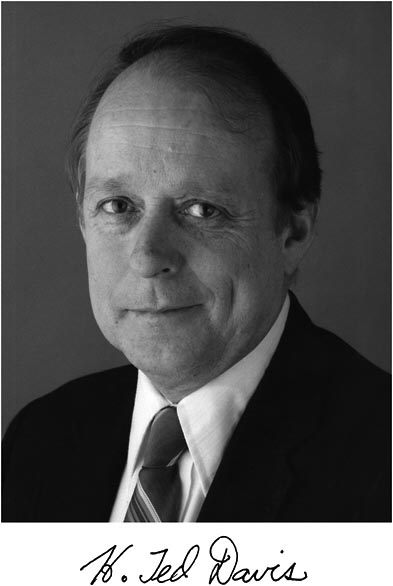H. TED DAVIS
1937–2009
Elected in 1988
“For leadership in applying chemical physics, and in uniting chemical engineering and materials science teaching and research.”
BY EDWARD L. CUSSLER
H. TED DAVIS, regents professor at the University of Minnesota, died suddenly on May 17, 2009, at the age of 71. Ted was born August 2, 1937, in Hendersonville, North Carolina, the son of an apple farmer and a textile mill worker. He earned his bachelor’s degree from Furman University and his Ph.D. in theoretical chemistry from the University of Chicago, working with Stuart Rice. After a postdoctoral year with Nobel laureate Ilya Prigogine at the Free University of Brussels, Ted joined the Department of Chemical Engineering (now Chemical Engineering and Materials Science) at the University of Minnesota, where he remained for 46 years.
Chemical engineering may seem a surprising destination for a theoretical chemist, but Ted was one of five chemists drawn to Minnesota at about the same time through the vision of Neal Amundson. Under the leadership first of Amundson and later of Ted, Minnesota’s Department of Chemical Engineering and Materials Science grew with the dramatically expanding chemical industry and has been acknowledged as one of the top departments in the discipline for half a century. The growth of the department, and of the discipline, depended less on traditional unit operations and more on mathematical analysis. This strategy was appropriate because
growth centered in the petroleum industry, where chemical composition could be described with continuous functions, rather than requiring only the periodic table. More recently, Ted led the expansion of chemical engineering into materials science, a continuing effort.
Ted’s own research reflected this transition from theoretical chemistry to chemical engineering. He made significant contributions to statistical mechanics, interfacial phenomena, and transport in porous media. His work on tertiary oil recovery, a long-standing collaboration with L. E. Scriven, continues to supply part of the scientific underpinning for efforts to use as much of the world’s oil supplies as efficiently as possible. I remain indebted to Ted for his efforts to teach me percolation theory. In all, Ted wrote over 400 papers and advised more than 80 graduate students. These intellectual accomplishments earned him the Walker Award from the American Institute of Chemical Engineers (1990) and election to the National Academy of Engineering (1988). In 1997, Davis was named a regents professor, the university’s highest recognition for faculty excellence. He received a Humboldt Research Award in 2005, and in 2008 he was inducted into the first class of the Minnesota Science and Technology Hall of Fame.
In 1995, Ted Davis became dean of the Institute of Technology, Minnesota’s college of physical science and engineering. During his tenure, he catalyzed establishment of the Digital Technology Center, the Department of Biomedical Engineering, and several programs in software and infrastructure engineering. As dean he not only seemed honest, but was honest. He also had the astonishing ability to change subjects effortlessly and to talk in depth about each: phase transitions, microwave bread baking, surface tension-driven instabilities, or improving his Corvette’s acceleration.
All of us who knew Ted still miss him every day.
Preceded in death by his wife, Eugenia; he is survived by his second wife, Kathy; son, Bill; daughter, Maria; one granddaughter, Evyenia (Evy) Davis; and sisters, Gwen Spangler and Judy Fitzgerald.





